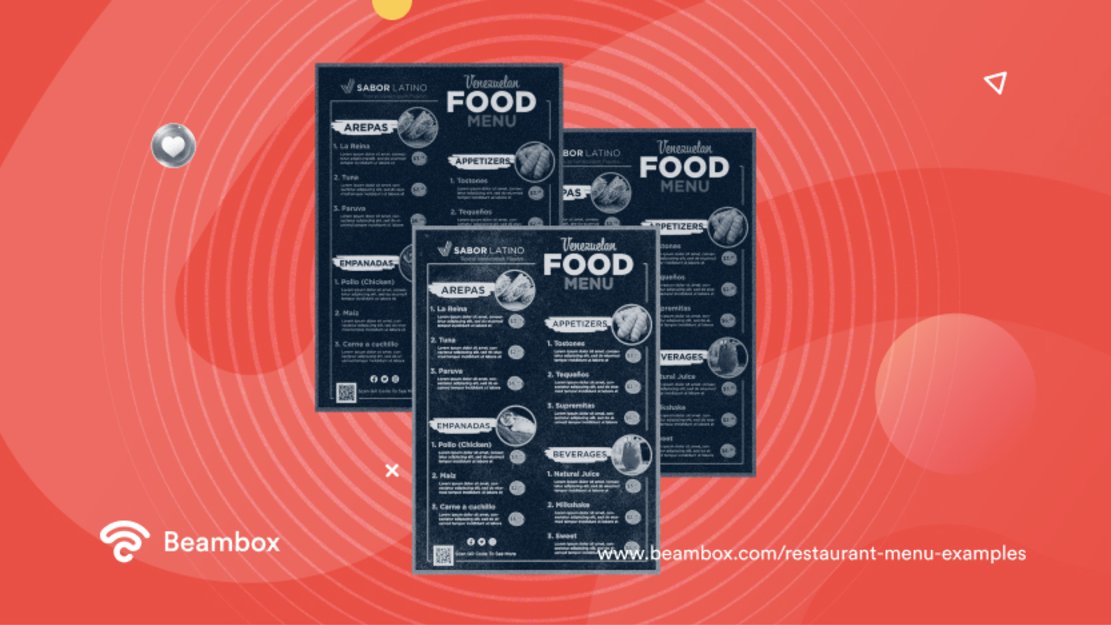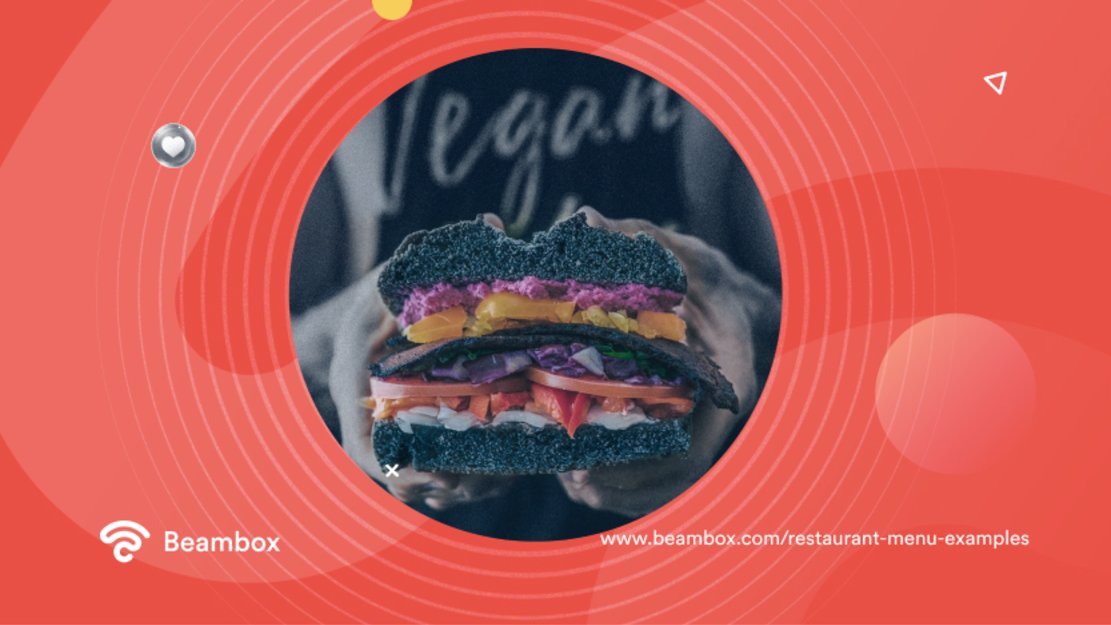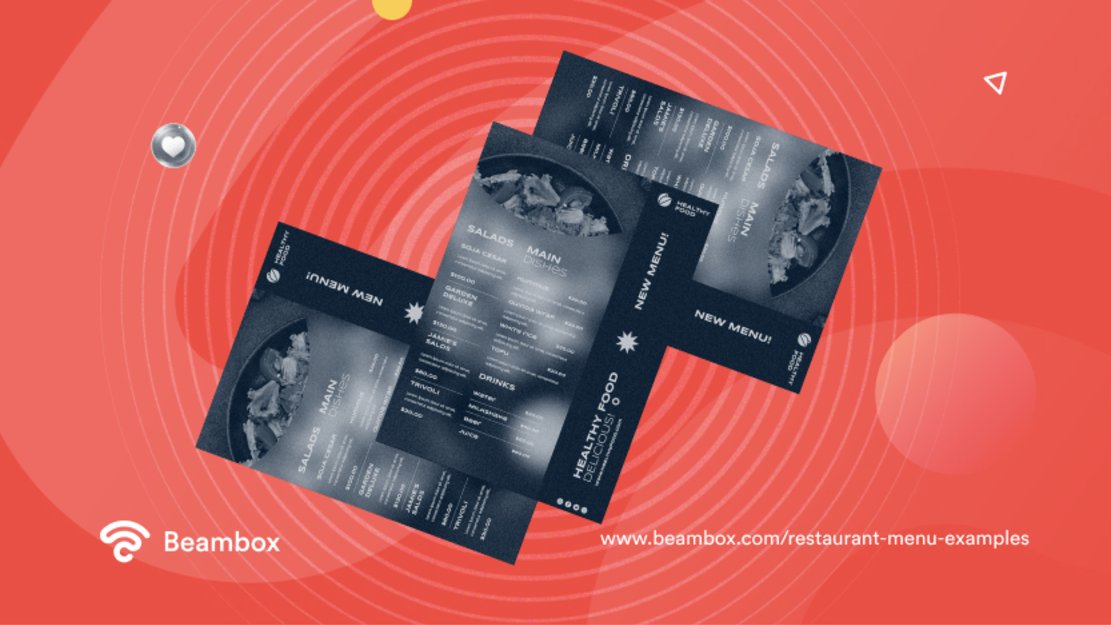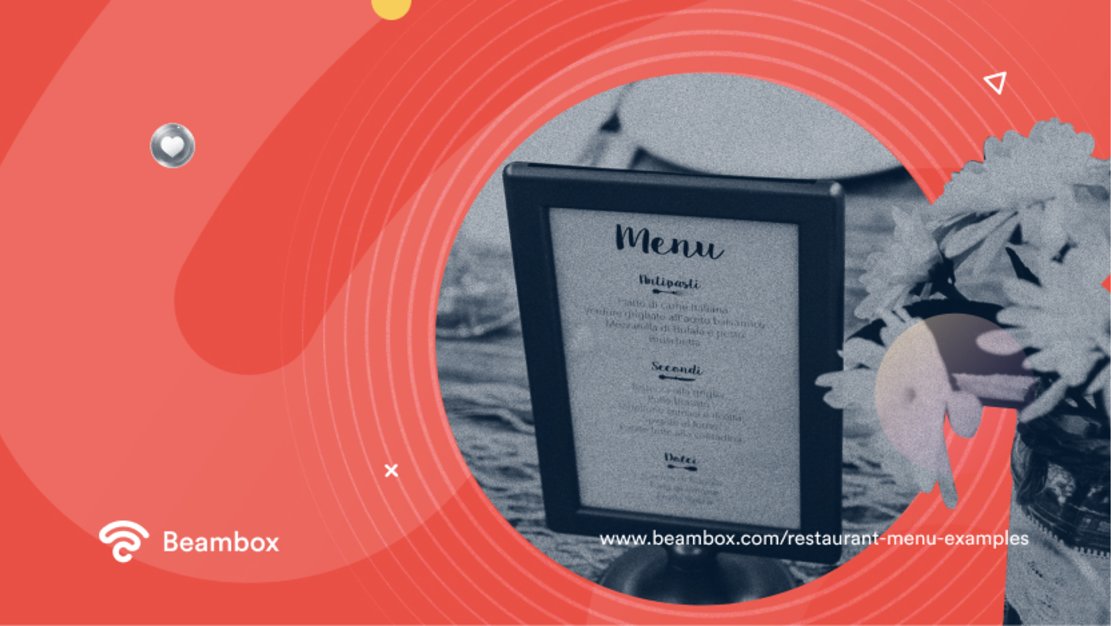Do you want to attract more customers to your restaurant? The key might be on your menu. But with so many dietary preferences, creating the perfect menu can get overwhelming. Here you will find various restaurant menu examples for each type of audience to help you get started.
So, are you ready to create drool-worthy menus that help you attract a wider audience? Then continue reading this article with a separate restaurant menu example to take inspiration from.

While getting inspiration from a restaurant menu example is crucial, there are specific steps you need to follow to create a menu that fits your brand. In this section, we will first go through these steps and then break down the above menu to see why it works. To create a menu:
- Define your restaurant concept: First, you need a clear idea of the theme of your restaurant. Who is your target audience? What types of cuisine will you serve? Answering these questions will help you create a menu that reflects your brand and appeals to your customers.
- Develop your menu categories: Once you have a concept, determine what categories you will offer. This typically includes appetizers, entrees, sides, desserts, and beverages.
- Choose your dishes: Select the dishes you want to offer within each category. Consider your target audience, their preferences, and popular trends in your area.
- Price your dishes: Consider the cost of ingredients, preparation time, and overhead expenses to price your dishes. Learn about menu pricing and ensure your prices are competitive with similar restaurants.
- Create descriptions: It is essential to create descriptions of the dishes that tell your customers about the ingredients present in each dish. Make this text appealing and engaging.
- Consider design and branding: The design of your menu should reflect your restaurant’s design and branding. Choose a layout, font, and color scheme consistent with your restaurant’s aesthetic.
Notice that the above menu sample design follows its branding with a consistent font, colors, and style. It also displays its promise to build trust. Moreover, it describes each dish as tasty and encourages customers to check the board for specials. Additionally, it has a clean design without a cluster of information.

It’s time to show you an à la carte menu example. But first, let’s understand what an à la carte menu is. It is a type of menu in which each dish has a different price. Customers can select individual items from the menu and create their meals according to their preferences.
It is commonly a part of fine dining or upscale restaurants. À la carte menus typically offer a wide range of options to mix and match. These options include appetizers, entrees, desserts, and beverages. While more flexible and customizable, it can be expensive because of separate prices.
Moreover, creating a meal with many options may be confusing or complicated. With that said, let’s break down the above restaurant menu example to see why it works.
Firstly, the brand has separated the dishes into clear categories. This makes the menu easy to read and understand. Secondly, it has incorporated its branding with its logo, colors, and font.
Additionally, each category has its picture to entice the reader. The description of key ingredients and flavor below the dish’s name can help the customers choose. To create an à la carte menu for your restaurant, take inspiration from this menu. A customized menu can be the simplest step to improve a restaurant business.
While the general tips above can help you create a menu, you must consider the different audiences that might attend your venue. This enables you to offer options that appeal to a broader range of customers. You can create a separate menu or add a small section with options for them.
This way, you can attract more customers and increase loyalty toward your business. It can also increase customer satisfaction and create positive word-of-mouth marketing for your restaurant.
That said, it’s time to look at some restaurant menu examples for different audiences.
Follow the Vegan Train: A Restaurant Menu Example for Vegans and Vegetarians
Let’s start with vegans and vegetarians. These people do not consume animal products for ethical, environmental, or health reasons. If your menu mainly comprises meat items, they won’t be able to avail of your offerings.
With many advancements in diets, you can easily cater to this audience. For example, the water from boiling chickpeas can replace egg whites! As a restaurant menu example for vegans, start with a flavorful and hearty option like tofu, tempeh, or seitan, and build your menu around it.
Offer a variety of vegetable dishes like salads, grain bowls, and veggie burgers. Or allow them to replace ingredients in regular dishes with veggie or plant options.

Go Fit and Fabulous: A Restaurant Menu Example for Fitness Enthusiasts
Now that we know how to add menu options for vegans and vegetarians let’s talk fitness. By 2028, the fitness industry will grow from 171.75% to $434.74 billion. This shows how rapidly people join the fitness train to maintain a healthy and active lifestyle. More and more people have started paying particular attention to what they eat.
As a restaurant owner, you can cater to this audience by providing healthy, nutritious options supporting their fitness goals. Start by offering lean protein options like grilled chicken, fish, or tofu. Pair them with side dishes like steamed vegetables, whole grains, or roasted sweet potatoes. Add superfoods like quinoa, chia seeds, or kale to your menu. Consider also farm-to-table ingredients.
Additionally, offer light, nonfat options that are still flavorful and satisfying. You can do this by opting for healthier cooking techniques such as grilling, baking, and steaming. This will help you differentiate your restaurant and appeal to the growing audience of fitness enthusiasts. Keep this restaurant menu example for fitness in mind for inspiration.

While catering to dietary preferences is essential, you must also add options that suit every age. Family dining provides options that appeal to both parents and children. Start by offering a range of options that cater to different age groups.
For a restaurant menu example for families, you can add simple and familiar dishes like mac and cheese, chicken tenders, or grilled cheese sandwiches. Consider more adventurous choices like ethnic cuisine, seafood, or vegetarian options.
Moreover, add options allowing everyone to share and try various dishes together. This could include larger portions of appetizers, sides, and entrees. Consider adding “half orders” of menu items to help parents order for their children.

If this is one of the most common types of menu, there must be a reason. By adding traditional dishes from your area, you can attract tourists and further increase your revenue. Offer a menu that highlights the unique culinary traditions of the local area. Your menu could feature regional specialties and ingredients that showcase the best of the destination.
Additionally, provide options catering to different tastes and dietary restrictions, such as vegetarian or gluten-free. Moreover, you can give information about each dish’s history and cultural significance. This can enhance the dining experience for tourists and give them a deeper appreciation of the destination’s culinary traditions.
For a restaurant menu example catering to tourists, suppose you have a restaurant in New York. You can include the classic pizza with a thin crust, tomato sauce, and mozzarella cheese. Another item could be grilled steak with roasted Brussels sprouts and mashed potatoes.

While catering to tourists will get you an international audience, considering the needs of businesspeople will help you retain the locals. Business people have busy schedules and must grab a quick bite without sacrificing quality and taste. Start by adding pre-packed meals that they can quickly reheat.
These options include salads, wraps, sandwiches, and protein bowls. In addition, offer meals that boost energy and focus, such as dishes high in protein and complex carbohydrates. For a restaurant menu example for business people, a grilled chicken breast with roasted vegetables and brown rice could work. Or quinoa and black bean bowl with avocado and salsa.
Another option is to offer customizable options to let customers choose their protein, sides, and toppings. Lastly, don’t forget about the importance of beverages. Offer a variety of options that boost energy, such as matcha tea.

Students are often looking for affordable options that won’t break the bank. To cater to this audience, it’s crucial to offer menu items that are both tasty and affordable. Moreover, these dishes should boost energy and focus.
Consider adding dishes that use economical ingredients such as beans, lentils, and grains.
You can use these ingredients to create filling and flavorful meals at a lower cost. Additionally, consider offering daily specials or meal deals to entice students to visit your restaurant.
Here is a restaurant menu example for students with potential items that are low in the budget because of the absence of meat:
- Vegetarian chili made with beans and vegetables served with cornbread
- Spaghetti with marinara sauce and a side salad
- Veggie quesadilla made with black beans, peppers, onions, and cheese
- Fried rice with mixed vegetables and tofu
- Veggie wrap with hummus, lettuce, tomato, and cucumber

After restaurant menu examples for unique audiences, it’s time to talk about special occasions. The wedding is one of the most important times in a person’s life so they require special menus. It’s vital to offer a wide variety of options to cater to all tastes and dietary needs of the guests. A wedding menu should be elegant, sophisticated and leave the guests amazed.
Start by asking the bride and groom their preferences and then building the menu. Here is a wedding menu example and some potential items it could include:
Appetizers:
- Asparagus wrapped in prosciutto with balsamic glaze
- Goat cheese and fig crostini
- Crab cakes with remoulade sauce
- Caprese skewers with fresh mozzarella, cherry tomatoes, and basil
Main course:
- Filet mignon with roasted garlic, mashed potatoes, and asparagus
- Grilled salmon with citrus glaze, served with wild rice and roasted vegetables
- Vegetable risotto with seasonal vegetables and parmesan cheese
- Stuffed Portobello mushrooms with goat cheese, spinach, and pine nuts
Desserts:
- Wedding cake with flavors such as vanilla, chocolate, or fruit fillings
- Strawberries covered in chocolate
- Assorted mini pastries and cookies
- Fresh fruit platter

When creating a menu for your restaurant, it’s important to gain inspiration from some restaurant menu examples. But to use them effectively, you need to understand your restaurant’s target audience and business goals. You also need to choose the type of menu that would best suit your target audience.
While an à la carte menu would be best for fine dining and businesspeople, it may be expensive for students. Use the prix fixe menu if your target audience prefers a complete dining experience without worrying about the cost of each dish.
Moreover, keep your branding in mind when designing your restaurant’s menu. Without your logo, colors, and font to differentiate yourself, your menu might get lost in the sea of competitors.
After you fix your menu, check out Beambox’s WiFi marketing platform. It will help you learn about your customer, grow your rating on local review sites, and customize your in-store WiFi.
Beambox integrates with most internet systems and has no hidden fees. Try Beambox for free and join 12,000 venues growing their business with WiFi marketing.
Get Started With Free WiFi Marketing
Beambox helps businesses like yours grow with data capture, marketing automation and reputation management.
Sign up for 30 days free